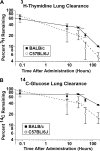Pulmonary responses to Stachybotrys chartarum and its toxins: mouse strain affects clearance and macrophage cytotoxicity
- PMID: 20385656
- PMCID: PMC2886860
- DOI: 10.1093/toxsci/kfq104
Pulmonary responses to Stachybotrys chartarum and its toxins: mouse strain affects clearance and macrophage cytotoxicity
Abstract
We investigated differences in the pulmonary and systemic clearance of Stachybotrys chartarum spores in two strains of mice, BALB/c and C57BL/6J. To evaluate clearance, mice were intratracheally instilled with a suspension of radiolabeled S. chartarum spores or with unlabeled spores. The lungs of C57BL/6J mice showed more rapid spore clearance than the lungs of BALB/c mice, which correlated with increased levels of spore-associated radioactivity in the GI tracts of C57BL/6J as compared with BALB/c mice. To identify mechanisms responsible for mouse strain differences in spore clearance and previously described lung inflammatory responses, we exposed alveolar macrophages (AMs) lavaged from BALB/c and C57BL/6J mice to S. chartarum spores, S. chartarum spore toxin (SST), and satratoxin G (SG) in vitro. The S. chartarum spores were found to be highly toxic with most cells from either mouse strain being killed within 24 h when exposed to a spore:cell ratio of 1:75. The spores were more lethal to AMs from C57BL/6J than those from BALB/c mice. In mice, the SST elicited many of the same inflammatory responses as the spores in vivo, including AM recruitment, pulmonary hemorrhage, and cytokine production. Our data suggest that differences in pulmonary spore clearance may contribute to the differences in pulmonary responses to S. chartarum between BALB/c and C57BL/6J mice. Enhanced AM survival and subsequent macrophage-mediated inflammation may also contribute to the higher susceptibility of BALB/c mice to S. chartarum pulmonary effects. Analogous genetic differences among humans may contribute to reported variable sensitivity to S. chartarum.
Figures






Similar articles
-
Comparison of inflammatory and cytotoxic lung responses in mice after intratracheal exposure to spores of two different Stachybotrys chartarum strains.Toxicol Sci. 2004 Apr;78(2):267-75. doi: 10.1093/toxsci/kfh064. Epub 2004 Jan 12. Toxicol Sci. 2004. PMID: 14718650
-
Strain differences influence murine pulmonary responses to Stachybotrys chartarum.Am J Respir Cell Mol Biol. 2006 Oct;35(4):415-23. doi: 10.1165/rcmb.2005-0483OC. Epub 2006 May 11. Am J Respir Cell Mol Biol. 2006. PMID: 16690987 Free PMC article.
-
Intranasal exposure to a damp building mould, Stachybotrys chartarum, induces lung inflammation in mice by satratoxin-independent mechanisms.Clin Exp Allergy. 2003 Nov;33(11):1603-10. doi: 10.1046/j.1365-2222.2003.01808.x. Clin Exp Allergy. 2003. PMID: 14616875
-
Attributes of Stachybotrys chartarum and its association with human disease.J Allergy Clin Immunol. 2004 Feb;113(2):200-8; quiz 209. doi: 10.1016/j.jaci.2003.12.018. J Allergy Clin Immunol. 2004. PMID: 14767429 Review.
-
Stachybotrys chartarum (chartarum = atra = alternans) and other problems caused by allergenic fungi.Allergy Asthma Proc. 2003 Jan-Feb;24(1):1-7. Allergy Asthma Proc. 2003. PMID: 12635571 Review.
Cited by
-
Stachybotrys musae sp. nov., S. microsporus, and Memnoniella levispora (Stachybotryaceae, Hypocreales) Found on Bananas in China and Thailand.Life (Basel). 2021 Apr 7;11(4):323. doi: 10.3390/life11040323. Life (Basel). 2021. PMID: 33917011 Free PMC article.
-
ATP mediates neuroprotective and neuroproliferative effects in mouse olfactory epithelium following exposure to satratoxin G in vitro and in vivo.Toxicol Sci. 2011 Nov;124(1):169-78. doi: 10.1093/toxsci/kfr213. Epub 2011 Aug 24. Toxicol Sci. 2011. PMID: 21865290 Free PMC article.
-
Implications of the Immune Landscape in COPD and Lung Cancer: Smoking Versus Other Causes.Front Immunol. 2022 Mar 21;13:846605. doi: 10.3389/fimmu.2022.846605. eCollection 2022. Front Immunol. 2022. PMID: 35386685 Free PMC article. Review.
-
Biochemical characterization of actinomycete from Namibia rocky crest mountainous soil and analyzing their bioactive metabolites for antagonistic effect against human respiratory pathogens.Pan Afr Med J. 2024 May 14;48:12. doi: 10.11604/pamj.2024.48.12.33596. eCollection 2024. Pan Afr Med J. 2024. PMID: 39184844 Free PMC article.
-
Environmental mold and mycotoxin exposures elicit specific cytokine and chemokine responses.PLoS One. 2015 May 26;10(5):e0126926. doi: 10.1371/journal.pone.0126926. eCollection 2015. PLoS One. 2015. PMID: 26010737 Free PMC article.
References
-
- Andersen B, Nielsen KF, Jarvis BB. Characterization of Stachybotrys from water-damaged buildings based on morphology, growth, and metabolite production. Mycologia. 2002;94:392–403. - PubMed
-
- Andersen B, Nielsen KF, Thrane U, Szaro T, Taylor JW, Jarvis BB. Molecular and phenotypic descriptions of Stachybotrys chlorohalonata sp. nov. and two chemotypes of Stachybotrys chartarum found in water-damaged buildings. Mycologia. 2003;95:1227–1238. - PubMed
-
- Chung YJ, Jarvis BB, Tak H, Pestka JJ. Immunochemical assay for satratoxin G and other macrocyclic trichothecenes associated with indoor air contamination by Stachybotrys chartarum. Toxicol. Mech. Meth. 2003a;13:247–252. - PubMed
-
- Chung YJ, Yang GH, Islam Z, Pestka JJ. Up-regulation of macrophage inflammatory protein-2 and complement 3A receptor by the trichothecenes deoxynivalenol and satratoxin G. Toxicology. 2003b;186:51–65. - PubMed
Publication types
MeSH terms
Substances
Grants and funding
LinkOut - more resources
Full Text Sources
Molecular Biology Databases

